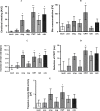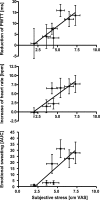Patterns of sympathetic responses induced by different stress tasks
- PMID: 19018304
- PMCID: PMC2577930
- DOI: 10.2174/1874205X00802010025
Patterns of sympathetic responses induced by different stress tasks
Abstract
Stress tasks are used to induce sympathetic nervous system (SNS) arousal. However, the efficacy and the patterns of SNS activation have not been systematically compared between different tasks. Therefore, we analyzed SNS activation during the following stress tasks: Presentation of negative, positive, and - as a control - neutral affective pictures, Color-Word interference test (CWT), mental arithmetic under time limit, singing a song aloud, and giving a spontaneous talk. We examined 11 healthy subjects and recorded the following SNS parameters: Activation of emotional sweating by quantitative sudometry, skin vasoconstriction by laser-Doppler flowmetry, heart rate by ECG, blood pressure by determination of pulse wave transit time (PWTT), and electromyographic (EMG) activity of the trapezius muscle. Moreover, subjective stress ratings were acquired for each task using a visual analog scale. All tasks were felt significantly stressful when compared to viewing neutral pictures. However, SNS activation was not reliable: Affective pictures did not induce a significant SNS response; singing, giving a talk and mental arithmetic selectively increased heart rate and emotional sweating. Only the CWT globally activated the SNS. Regarding all tasks, induction of emotional sweating, increase of heart rate and blood pressure significantly correlated with subjective stress ratings, in contrast to EMG and skin vasoconstriction.Our results show that the activation of the SNS widely varies depending on the stress task. Different stress tasks differently activate the SNS, which is an important finding when considering sympathetic reactions - in clinical situations and in research.
Figures


Emotional sweating is expressed as area under the sweating curve (AUC). Singing (p < 0.05), CWT (p <0.01), giving a talk (p <0.05) and mental arithmetic (p < 0.05) induced significant emotional sweating as compared to baseline. Significant differences to neutral affective pictures are indicated by stars.
Skin blood flow vasoconstriction (differences of flux values, FV). Compared to baseline, presentation of positive (p < 0.05) and negative pictures (p < 0.05), singing (p < 0.05), CWT (p < 0.05) and mental arithmetic (p < 0.05) led to significant vasoconstriction. Significant differences to neutral affective pictures are indicated by stars.
Heart rate increase as compared to baseline (bpm). Singing (p < 0.01), CWT (p < 0.05), giving a talk (p < 0.05) and mental arithmetic (p < 0.01) induced significant increase of heart rate as compared to baseline. Significant differences to neutral affective pictures are indicated by stars.
Reduction of PWTT (ms). Singing (p < 0.01), CWT (p < 0.01), giving a talk (p < 0.01) and mental arithmetic (p < 0.05) caused significant reduction of PWTT as compared to baseline. Significant differences to neutral affective pictures are indicated by stars.
Activity in trapezius muscle EMG (µV). Singing (p <0.05), CWT (p < 0.05) and giving a talk (p < 0.05) significantly increased trapezius muscle EMG activity as compared to baseline. Significant differences to neutral affective pictures are indicated by stars.
neutr: neutral affective pictures; pos: positive affective pictures; sing: singing; neg: negative affective pictures; CWT: Color-Word interference test; talk: giving a talk; calc: mental arithmetic; *: p < 0.05; **: p < 0.01.

Similar articles
-
Stress and thermoregulation: different sympathetic responses and different effects on experimental pain.Eur J Pain. 2009 Oct;13(9):935-41. doi: 10.1016/j.ejpain.2008.11.002. Epub 2009 Jan 10. Eur J Pain. 2009. PMID: 19136286
-
Effects of mental and physical demands on heart rate variability during computer work.Eur J Appl Physiol. 2002 Aug;87(4-5):456-61. doi: 10.1007/s00421-002-0656-7. Epub 2002 Jun 28. Eur J Appl Physiol. 2002. PMID: 12172887
-
Sympathetic activity is influenced by task difficulty and stress perception during mental challenge in humans.J Physiol. 1992 Aug;454:373-87. doi: 10.1113/jphysiol.1992.sp019269. J Physiol. 1992. PMID: 1474496 Free PMC article.
-
Role of sympathetic nervous system in hypertension and effects of cardiovascular drugs.Eur Heart J. 1998 Jun;19 Suppl F:F32-8. Eur Heart J. 1998. PMID: 9651733 Review.
-
Sympathetic nervous system activity and female sexual arousal.Am J Cardiol. 2000 Jul 20;86(2A):30F-34F. doi: 10.1016/s0002-9149(00)00889-4. Am J Cardiol. 2000. PMID: 10899275 Review.
Cited by
-
A qualitative study exploring the effects of attending a community pain service choir on wellbeing in people who experience chronic pain.Br J Pain. 2016 Aug;10(3):124-34. doi: 10.1177/2049463716638368. Epub 2016 Mar 22. Br J Pain. 2016. PMID: 27583139 Free PMC article.
-
Regional brain responses associated with thermogenic and psychogenic sweating events in humans.J Neurophysiol. 2015 Nov;114(5):2578-87. doi: 10.1152/jn.00601.2015. Epub 2015 Aug 19. J Neurophysiol. 2015. PMID: 26289468 Free PMC article.
-
Heart rate changes during freezing of gait in patients with Parkinson's disease.Mov Disord. 2010 Oct 30;25(14):2346-54. doi: 10.1002/mds.23280. Mov Disord. 2010. PMID: 20721914 Free PMC article.
-
Emotion suppression and acute physiological responses to stress in healthy populations: a quantitative review of experimental and correlational investigations.Health Psychol Rev. 2024 Jun;18(2):396-420. doi: 10.1080/17437199.2023.2251559. Epub 2023 Aug 30. Health Psychol Rev. 2024. PMID: 37648224 Free PMC article.
-
Stress-Related Responses to Alternations between Repetitive Physical Work and Cognitive Tasks of Different Difficulties.Int J Environ Res Public Health. 2020 Nov 17;17(22):8509. doi: 10.3390/ijerph17228509. Int J Environ Res Public Health. 2020. PMID: 33212862 Free PMC article.
References
-
- Waldstein SR, Siegel EL, Lefkowitz D, et al. Stress-induced blood pressure reactivity and silent cerebrovascular disease. Stroke. 2004;35(6):1294–8. - PubMed
-
- Heiden M, Barnekow-Bergkvist M, Nakata M, Lyskov E. Autonomic activity pain and perceived health in patients on sick leave due to stress-related illnesses. Integr Physiol Behav Sci. 2005;40(1):3–16. - PubMed
-
- Vasseljen O Jr, Westgaard RH. Can stress-related shoulder and neck pain develop independently of muscle activity?. Pain. 1996;64(2):221–30. - PubMed
-
- Birklein F, Spitzer A, Riedl B. The assessment of sudomotor function for diagnosis of autonomic diseases Principles and methods. Fortschr Neurol Psychiatr. 1999;67(7):287–95. - PubMed
-
- Lang PJ, Bradley MM, Cuthbert BN International affective picture system (IAPS) Technical Report A-6 University of Florida . FL: Gainesville; 2005. Affective ratings of pictures and instruction manual.
LinkOut - more resources
Full Text Sources
